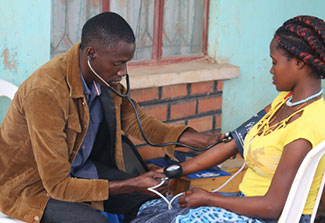Celebrating 30 years of capacity building in Rakai, Uganda to advance research discoveries
September / October 2019 | Volume 18, Number 5

Photo by Jackie Mckina/Rakai Health Sciences Program
The Rakai Health Sciences Program in Uganda, which is
marking its 30th anniversary this year, has played a vital role
in preparing low- and middle-income country scientists for the
battle against HIV/AIDS.
Opinion by Fogarty Director Dr Roger I Glass
A paper published by a group of Ugandan researchers in October 1985 described a mysterious illness, called “slim disease,” which had killed 100 people in the country’s Rakai district. It was a seminal moment that awoke the world to the looming HIV/AIDS crisis.
The investigations begun then have grown into the
Rakai Health Sciences Program, which is marking its 30th anniversary this year. For Fogarty, it’s a wonderful opportunity to celebrate three decades of research capacity building that have resulted in numerous groundbreaking scientific discoveries.
The idea that our small center could play a vital role in preparing low- and middle-income country scientists for the battle against HIV/AIDS came from Fogarty’s Dr. Ken Bridbord. As co-chair of the third International Conference on AIDS, held in Washington D.C. in 1987, it became clear to him that a dramatic response was required that should include a rapid scaling up of scientific capacity in Africa and other places where the death toll was quickly rising. Ken conceived an innovative program consisting of mentored research projects, in addition to formal coursework. The result was the AIDS International Training and Research Program, which supported training for more than 2,000 scientists and clinicians in more than 100 developing countries. The initiative was revised to meet evolving needs and continues today as the
Fogarty HIV Research Training Program.
In Rakai, the early years of the epidemic were devastating. An HIV diagnosis was a virtual death sentence, with those effected wandering around listlessly with open sores, being shunned by all. Witnessing such suffering gave researcher
Fred Nalugoda chills and he thought he could not go back. Now field director and a principal investigator in Rakai, Nalugoda says public awareness and the availability of treatment have dramatically improved the situation.
Another Fogarty alum,
Dr. Elioda Tumwesigye, is now Uganda’s minister of science and technology. He says without the opportunity to receive advanced training funded by Fogarty, he simply wouldn’t be who he is today. That support helped him reach significant career milestones such as starting the first standing committee on HIV in any African parliament and being selected for his current position.
Virtually the entire leadership team at Rakai has benefited from Fogarty training or research funding. In partnership with Johns Hopkins University, training conducted has run the gamut from lab methodology and bioethics to epidemiology, biostatistics and pathology. That laid the groundwork for this small but mighty team to make scientific contributions detailed in a whopping 573 publications, on the implications of circumcision on HIV transmission prevention and numerous other important issues. Those articles have been cited more than 20,000 times, clearly demonstrating the findings’ significance.
Today, Rakai is engaged in about a dozen NIH-funded research projects, devoted to pressing issues such as how to improve prevention and treatment among adolescents, and ways to make better use of mobile technologies.
But even as we review these incredible accomplishments, we must not rest on our laurels. Much still remains to be done. For instance, it is my hope that the Rakai grants, which are managed by Hopkins, will someday transition to directly fund the Ugandan research leaders themselves. A trove of data and specimens have been collected. We must make sure it is thoroughly mined so we can all learn from these decades-long studies of this population that was so greatly impacted by the epidemic.
Over the next decade, it’s my hope that the Rakai team will not only continue to gain control of the epidemic and improve treatment for those living with HIV, but will also continue to branch out to other pressing issues such as noncommunicable diseases, and maternal and child health. They must carry on strengthening training resources so they can adequately prepare the next generation of scientists. By bringing in new partners, they may expand south-south partnerships and ensure sustainability of all that has been achieved.
We owe this small community of committed researchers a debt of gratitude for all the knowledge they have given us, from their post on the front lines of this terrible scourge. Paraphrasing Sir Winston Churchill, never was so much owed by so many to so few!
More Information
To view Adobe PDF files,
download current, free accessible plug-ins from Adobe's website.